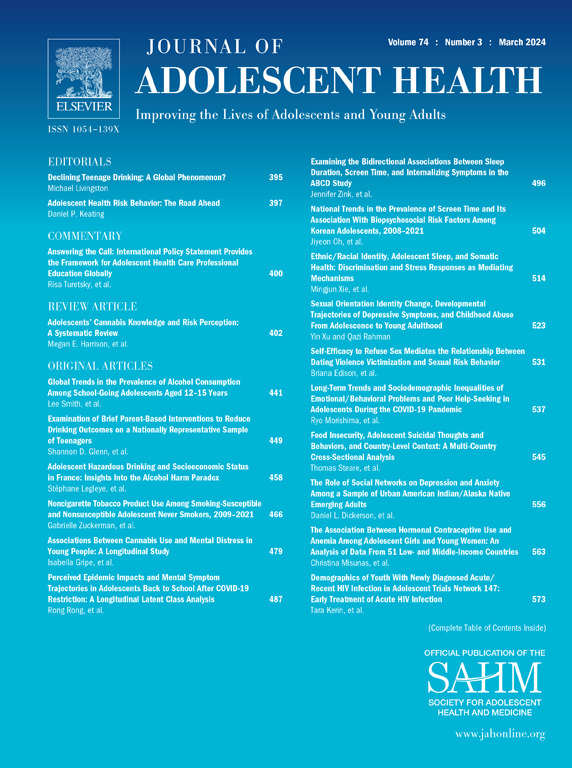美国儿科医生对青少年药物使用筛查的态度和做法。
IF 4.5
2区 医学
Q1 PEDIATRICS
引用次数: 0
摘要
目的:研究初级保健儿科医生对药物使用筛查的态度和做法,包括筛查的障碍。方法:2021年美国儿科学会定期调查由1683名未退休的美国儿科学会成员(住院医师除外;回应率43%)。报告向青少年提供健康监督的儿科医生(n = 455)完成了评估物质使用筛查做法和态度的调查项目,包括筛查和获得治疗资源的障碍。多变量逻辑回归确定了医生和执业水平特征与(1)使用标准化药物使用筛查工具和(2)药物使用筛查障碍之间的关联。结果:10名初级保健儿科医生中有9名(404/455)报告在健康监督访问期间总是/经常筛查青少年患者的物质使用情况,41%通常使用标准化仪器。与东北地区相比,南方儿科医生(调整后优势比0.56;95%可信区间[CI] 0.32-0.97),中西部(校正优势比0.26;95% CI 0.13-0.49)或West (0.46;95% CI 0.25-0.85)报告使用标准化筛查工具的可能性为一半。筛查最常见的障碍是筛查呈阳性的青少年缺乏治疗选择(69%),缺乏现场药物使用咨询提供者(67%),以及需要更多咨询信息(50%)。大多数儿科医生报告说,很难/非常难以找到针对青少年药物使用的门诊行为干预(76%)、住院治疗(79%)或药物管理服务(73%)。讨论:这些数据突出了美国地区物质使用筛查实践的可变性。加强筛查工作人员培训和提供转诊资源的系统级干预措施可能有助于克服筛查障碍。本文章由计算机程序翻译,如有差异,请以英文原文为准。
U.S. Pediatricians' Attitudes and Practices Around Screening for Substance Use in Adolescents
Purpose
To examine primary care pediatricians' attitudes and practices around substance use screening, including barriers to screening.
Methods
The 2021 American Academy of Pediatrics Periodic Survey was completed by a national, random sample of 1,683 nonretired US American Academy of Pediatrics members (residents excluded; response rate 43%). Pediatricians who reported providing health supervision to adolescents (n = 455) completed survey items assessing substance use screening practices and attitudes, including barriers to screening and access to treatment resources. Multivariable logistic regression identified associations between physician- and practice-level characteristics and (1) using a standardized substance use screening instrument and (2) barriers to substance use screening.
Results
Nine of 10 primary care pediatricians (404/455) reported always/often screening adolescent patients for substance use during health supervision visits, with 41% usually using a standardized instrument. Compared to those in the Northeast, pediatricians in the South (adjusted odds ratio 0.56; 95% confidence interval [CI] 0.32–0.97), Midwest (adjusted odds ratio 0.26; 95% CI 0.13–0.49), or West (0.46; 95% CI 0.25–0.85) were half as likely to report use of a standardized screening instrument. The most common barriers to screening were a lack of treatment options for adolescents with a positive screen (69%), a lack of on-site substance use counseling providers (67%), and needing more information on counseling (50%). Most pediatricians reported it was difficult/very difficult to find outpatient behavioral interventions (76%), inpatient treatment (79%), or medication management services (73%) for adolescent substance use.
Discussion
These data highlight variability in substance use screening practices by US region. Systems-level interventions that strengthen workforce training on screening and the availability of referral resources may help overcome barriers to screening.
求助全文
通过发布文献求助,成功后即可免费获取论文全文。
去求助
来源期刊

Journal of Adolescent Health
医学-公共卫生、环境卫生与职业卫生
CiteScore
10.40
自引率
3.90%
发文量
526
审稿时长
46 days
期刊介绍:
The Journal of Adolescent Health is a scientific publication dedicated to enhancing the health and well-being of adolescents and young adults. Our Journal covers a broad range of research topics, spanning from the basic biological and behavioral sciences to public health and policy. We welcome a variety of contributions, including original research papers, concise reports, literature reviews, clinical case reports, opinion pieces, and letters to the editor. We encourage professionals from diverse disciplines such as Anthropology, Education, Ethics, Global Health, Health Services Research, Law, Medicine, Mental and Behavioral Health, Nursing, Nutrition, Psychology, Public Health and Policy, Social Work, Sociology, and Youth Development to share their expertise and contribute to our mission of promoting adolescent health. Moreover, we value the voices of young individuals, family and community members, and healthcare professionals, and encourage them to submit poetry, personal narratives, images, and other creative works that provide unique insights into the experiences of adolescents and young adults. By combining scientific peer-reviewed research with creative expressions, our Journal aims to create a comprehensive understanding of the challenges and opportunities in adolescent and young adult health.
 求助内容:
求助内容: 应助结果提醒方式:
应助结果提醒方式:


